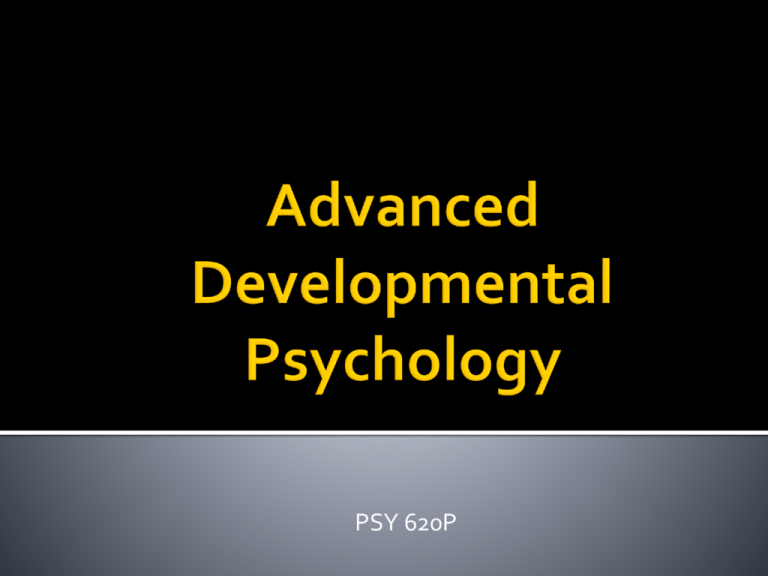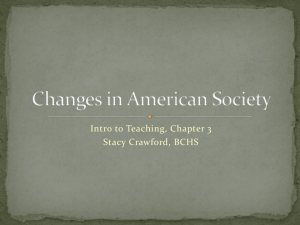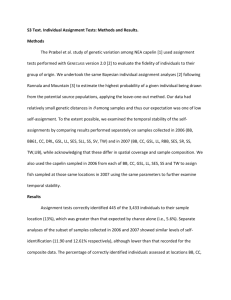ppt12
advertisement

PSY 620P Kelly Shaffer Messinger Behavior Similarity Correlation 60 50 40 30 Twin 1 Twin 2 20 10 0 Dizygotic Monozygotic Genetic Relatedness Messinger SES-related disparities widen over course of childhood Cumulative environmental damage 72% high SES families Greater influence of genes 10% low SES families Greater influence of environment Heritability of Cognitive Ability = 50% in General Population Shaffer | Tucker-Drob et al., 2011 750 twin pairs from Early Childhood Longitudinal Study, Birth Cohort (ECLS-B) Assessed at 10 months and 2 years old Zygosity: Shaffer | Tucker-Drob et al., 2011 Effect of genes on mental ability increases over infant development in high SES case (Tucker-Drob, et al.. (2011) Fernandez Shaffer | Tucker-Drob et al., 2011 “Although SES is often conceived of as a purely environmental variable, socioeconomic groups may differ in the frequencies of specific genetic polymorphisms” Are SES and genes confounding variables? “We overinvest in most schooling and post-schooling programs and underinvest in preschool programs for disadvantaged persons” Do you agree? Shaffer | Tucker-Drob et al., 2011 Devika Jutagir Individual differences in intelligence: Hereditarian perspective: Individual differences in intelligence are primarily genetic. Sociological perspective: Differences primarily rooted in environmental experience. Scarr-Rowe hypothesis: “IQ scores within advantaged groups will show larger proportions of genetic variance and smaller proportions of environmental variance than IQ scores for disadvantaged groups. Environmental disadvantage is predicated [sic] to reduce the genotypephenotype correlation in lower-class groups.” Results of studies on the Scarr-Rowe hypothesis are mixed. Jutagir | Tucker-Drob & Bates, 2015 1) Does the range of studies from the United States support a positive estimate of Gene × SES interaction on achieved IQ? 2) Do studies on participants outside the United States show a similar greater-than-zero Gene × SES effect? 3) Can a single estimate adequately account for all of the observed effect sizes, or are separate estimates necessary to represent effect sizes from the United States and from Western Europe and Australia? Jutagir | Tucker-Drob & Bates, 2015 Search terms: twin, gene, socioeconomic status, education, income. Inclusion criteria: 1) 2) 3) 4) 5) Intelligence/achievement continuously measured with objective performance-based test. Inference of genetic influence had to be made using siblings (preferably twins) with varying degrees of genetic relatedness. Degree of genetic relatedness known to a high degree of certainty. Ordered categorical/continuous measure of childhood family SES examined as moderator of genetic variance in intelligence/achievement. Participants not selected on the basis of psychiatric or medical diagnoses, patient status, or intelligence/achievement test scores. 14 independent studies 43 effect sizes. 24,926 pairs of twins and siblings. Jutagir | Tucker-Drob & Bates, 2015 Jutagir | Tucker-Drob & Bates, 2015 Jutagir | Tucker-Drob & Bates, 2015 Jutagir | Tucker-Drob & Bates, 2015 1) Does the range of studies from the United States support a positive estimate of Gene × SES interaction on achieved IQ? Yes 2) Do studies on participants outside the United States show a similar greater-than-zero Gene × SES effect? No 3) Can a single estimate adequately account for all of the observed effect sizes, or are separate estimates necessary to represent effect sizes from the United States and from Western Europe and Australia? Jutagir | Tucker-Drob & Bates, 2015 “Gene × SES effects are not uniform but can rather take positive, zero, and even negative values depending on factors that differ at the national level.” “Further research on between-nations variability in the effects of family SES on cognitive development is particularly important.” Possible mechanisms underlying variability: National differences in how concepts of letter and number that underpin literacy and numeracy are imparted (Ramani & Siegler, 2008). Educational quality (Taylor, Roehrig, Soden Hensler, Connor, & Schatschneider, 2010). Medical and educational access (Bates et al., 2013; Tucker-Drob et al., 2013). Macrosocietal characteristics (e.g., upward social mobility; Ritchie, Bates, & Plomin, 2014). Income support (Duncan, Morris, & Rodrigues, 2011). Jutagir | Tucker-Drob & Bates, 2015 “It is in contrast to severe deprivation that enrichment shows its statistically significant effects.” ▪ Gottlieb & Blair, 2004 Messinger Rodent research: early experiences avert the deterioration of learning ability seen when rodents are reared in impoverished conditions It is only in comparison to impoverished conditions that enrichment shows an influence Exposure to enriched conditions after exposure to impoverished conditions does not matter Bell Its early experience that’s important Table 2. Mean Errors in Hebb-Williams Maze of Rats With Different Early and Late Environmental Experiences Free environment/ Stovepipe/ Stovepipe Free environment 161 248 Free environment/ Normal Cage/ Free environment Normal Cage 152 221 Note. Data from Hymovitch (1952). The Stovepipe/Free Environment and Normal Cage groups made significant more errors than the other two groups (p <.001). Bell Birth – 5 years: “comprehensive educational daycare intervention” “utilized developmentally appropriate curricula designed to facilitate children’s language, motor, social, and cognitive growth. ▪ Full-day care, 50-weeks per year, 93% enrolled by 3 months 5 – 8: “school age intervention delivered through home visitors, liaisons between home and school. designed to increase parent involvement in the educational process Messinger Gottlieb & Blair (2004) (cont) Short-term Effects of Early Intervention on IQ Longer-term Effects of Early vs. Later Intervention Nielsen & Tomaselli (2010) Why expect cultural differences in children’s tendency to overimitate? Hermann et al. 2010 Ni Sun-Suslow Comparing cognitive performance of chimpanzees, orangutans, and 2-year-old humans on a wide-ranging battery of cognitive tasks: All species has same basic cognitive skills in physical domain Human children showed more skills in social domain Ni Sun-Suslow Hypothesis: Children would show a distinct factor for social intelligence, whereas chimpanzees would not. Population: Chimpanzees Humans N 106 105 Ages 3-21 years 2.5 years Females 50% 50% (ethnicity?) Uganda, Republic of Congo Mostly German Ni Sun-Suslow Best fitting model for children Hermann et al. (2009) Best fitting model for chimpanzees Structural networks: anatomical connections linking cortical and subcortical brain regions Functional networks: Set of connections among brain regions derived by observing neural activity during tasks and rest ’Right fronto-insular cortex (rFIC) is a component of a salience network (SN) mediating interactions between large-scale brain networks involved in externally oriented attention [central executive network (CEN)] and internally oriented cognition [default mode network (DMN)]. The causal influence of the rFIC on nodes of the SN and CEN was greater in adults than children. Cognition and behavior results from interconnected structural and functional brain networks Changing brain connectivity causes AND results from developmental changes in behavior Pick up an object, hold, Brain Networks Behavior rotate, use object. Visual information is generated that supports visual object recognition TIME Infants and precocious reaching experience: Infants wore Velcro mittens Early experience leads to increases in later visual attention to objects and oral exploration of objects https://www.youtube.com/watch?v=hJGRM4 LFJjU





